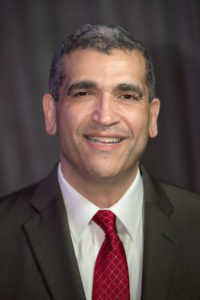- Urban Legends: Anesthesia Economic Issues
- 1:15-2:15 p.m. Tuesday
- North, Room 25
Anesthesiologists everywhere hear urban legends presented as fact by hospital administrators, consultants, surgeons, O.R. managers and others. And like many legends, there is more wishful thinking involved than reality.
“These are common issues that come up frequently in negotiations and staffing discussions,” said Amr Abouleish, M.D., M.B.A., Professor of Anesthesiology at the University of Texas Medical Branch in Galveston. “I’m going to give our attendees in San Francisco some solid, evidence-based arguments to refute four of the most common urban legends about anesthesiology and economics.”

Amr Abouleish, M.D., M.B.A., challenges urban legends in anesthesiology and economics.
Dr. Abouleish will moderate Tuesday’s session “Urban Legends: Anesthesia Economic Issues.” Anesthesiologists will immediately recognize the realities of everyday life in the O.R. But there’s a good chance they have never looked at these common legends from an evidentiary perspective.
Consider physician-only staffing compared to the medical direction model. Conventional wisdom looks at the comparative salaries for private practice physician anesthesiologists, over $400,000 annually, and nurse anesthetists, around $190,000 annually. The easy conclusion is that institutions could hire two nurse anesthetists for every physician anesthetist. The reality is more complex.
For starters, nurse anesthetists work 40-hour weeks. Overtime rates apply to additional hours. Physician anesthesiologists work an average of 55 hours per week, 15 of those hours on weekends, holidays, after hours and on-call.
That’s the equivalent of working 62.5 hours per week at regular salary, Dr. Abouleish said. At that rate, the hourly salaries for private practice physicians and nurse anesthetists become closer. If you compare nurse anesthetists to academic anesthesiologists, the typical salaries are identical.
“This is a paradigm shift in economic thinking,” Dr. Abouleish said. “The cheapest staffing may be some physician-only and some medical-directed. It gets more complex when you start looking at matching the number of nurse anesthetists to the number of operating rooms, covering for them on breaks and lunch and some of the other details. The bottom line is that going from physician-only anesthesia to the anesthesia care team model does not automatically reduce costs. And that doesn’t take into account that physician anesthesiologists can cover the recovery room, perform post-op pain blocks, staff the ICU and provide a physician assessment of a patient preoperatively. ”
The arguments are just as complex when it comes to improving O.R. utilization and throughput. It’s easy to focus on turnover time, but cutting turnover time will not necessarily improve O.R. throughput.
“It is possible to improve throughput, but only by focusing on the whole perioperative experience, looking at the whole picture and everyone involved,” Dr. Abouleish said. “If you don’t include the surgeons, it’s not going to work. There are too many factors involved, including variation in surgical volume, non-operative time, redundant information collection and engagement. Only when you look at the entire picture is it possible to improve O.R. throughput.”
Return to Archive Index